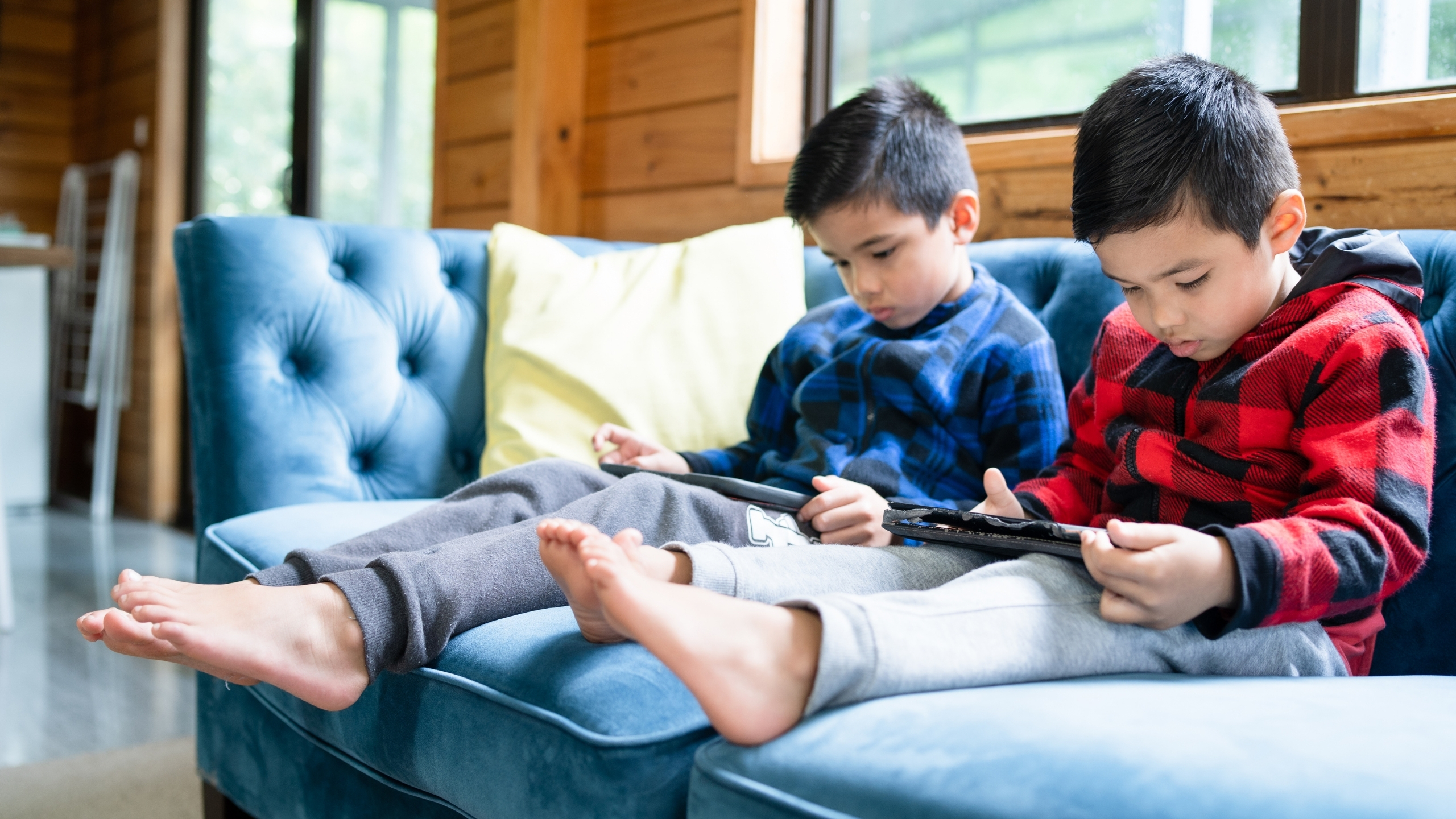
Screen Time Debate: Ignoring Working-Class Family Struggles?
The screen time debate continues to explode in 2025. Parents are bombarded by warnings about limits on kids screen time with dangers to reduced attention span and increased reference to social isolation. Experts, doctors and influencers promote an often dominant narrative about kids and screens that lay full blame on screens as the ultimate villain in parenting. Yet for a working-class parent that has spent the last decade juggling multiple jobs with two kids in daycare/school, I have to ask, is that the conversation that most families can relate with? At least families like mine who rely on screens to alleviate daily needs.
The life of the working-class family-those that earn below the median household income of $81,060 (2024 U.S. Census Bureau) is not the same, and not a pretty picture when parenting blogs email about parental choices and idealized stories. For many parents, who belong to the roughly 60% of U.S. households that function under dual income employment (BLS, 2025), enforcing screen time limits does not seem feasible.
Also read 👉Homemade vs. Store-Bought Baby Food: Best Choice for Baby
This post will assess how the screen time debate excludes the voices of the working-class families and get into some of the challenges working-class families face with screens, how screens play an important role in many families lives, and practical ideas for balancing those challenges. Supported by statistics, real-life examples, and an objective conversation, I will give you the view important to you. Lets do this.
Why the Screen Time Debate Feels Out of Touch
The American Academy of Pediatrics (AAP) states that there should be no screens for children younger than 18 months old (except for video chats) and 2-5 hours for older children (dependent on child age). Thus, the AAP guidelines, though well-intentioned, likely envision a level of control over screen time that many working-class parents cannot hope to develop. A 2024 Pew Research study shows that 70% of low-income parents feel judged for allowing their kids more screen time than recommended, while 65% feel they have relied on their devices to maintain their children's productivity during work hours.

Why is there a gap between what parents are encouraged to do and the realities? The conversation about screen time often involves something of a default setting of middle- and upper-class families who have childcare help, flexible work schedules, or families in which parents don't work. For working-class families-consider single moms, respondents who are hook for shifts, or parents who do not have relatives nearby-screens are an essential lifeline, not a luxury. Let's slice through the challenges facing each family type and see how that shapes the screen-time reality.
The Unique Struggles of Working-Class Families
1. Time Constraints and Long Work Hours
A lot of working-class parents work one, two, or even three jobs, almost always on non-standard shifts. The 2025 BLS reports that of low-wage workers, 45% have non-standard hours, including working evenings and weekends. Working, raising kids and managing the household does not afford working-class families the luxury of time to engage in hands-on parenting or structured activities for their children. Screens-whether tablets, televisions, or phones-are a safe, inexpensive way to find engagement for kids.
Example: Maria, a nurse and single-parent who works 12-hour night shifts. She has an 8-year-old daughter who uses a tablet to watch educational shows or to play math games (while Maria sleeps between shifts). Maria would be unable to rest, let alone be able to get other household tasks completed, without some sort of device.
2. Limited Access to Childcare
High-quality childcare is considered a luxury. The National Institute for Early Education Research (2024), reports that the average cost of preschool is $12,000 a year, making it far too high for families earning 40k or less yearly. Many families cannot access daycare or family support, so they rely on screens to fill the gap, especially when working remotely or taking time off work during school breaks.
Example: A coworker, also a retail worker, said that during summer break, she would have relied on Youtube Kids to entertain her 5 year old son since local summer camps were 200 dollars per week, or half of her checks.
3. Financial Barriers to Alternatives
The screen time debate often suggests replacing devices with activities like sports, music lessons, or museum trips. But these come with costs-equipment, fees, or transportation-that strain tight budgets. A 2025 Aspen Institute study found that 55% of low-income families can’t afford extracurriculars, leaving screens as a free or low-cost option.
Example: A neighbor’s son wanted to join soccer, but the $150 registration fee was out of reach. Instead, he plays soccer apps and watches tutorials online, keeping him engaged without breaking the bank.
4. Digital Divide and Educational Needs
Screens aren’t just entertainment-they’re educational tools. With 20% of low-income households lacking reliable broadband (FCC, 2025), families prioritize devices for schoolwork. Many kids rely on tablets for homework, virtual tutoring, or free educational platforms like Khan Academy.
Example: My cousin’s 10-year-old uses a school-provided tablet for math practice because their family can’t afford a private tutor. It’s a necessity, not a choice.
The Role of Screens in Working-Class Homes
Screens aren’t the enemy-they’re a tool. For working-class families, devices serve multiple purposes:
Childcare Support: Keep kids safe and occupied during work hours.
Education: Provide access to free learning resources when tutoring or books are costly.
Entertainment: Offer affordable fun compared to expensive outings.
Connection: Enable video calls with distant relatives, strengthening bonds.
A 2024 Common Sense Media study found that 80% of low-income parents view screens as “essential” for managing daily life, compared to 50% of higher-income parents. The debate’s focus on limiting screen time ignores these practical roles.

Practical Solutions for Balanced Screen Time
The screen time debate needs to shift from judgment to support. Here are practical ways working-class parents can balance screen use while addressing their realities, based on expert advice and my own experience.
1. Set Realistic Boundaries
Instead of rigid time limits, create flexible guidelines that fit your schedule. The AAP suggests focusing on quality over quantity-prioritize educational or interactive content over passive watching.
How to Do It:
Use timers or parental control apps like Qustodio (free version available) to cap recreational screen time at 1–2 hours daily.
Designate “screen-free” moments, like dinner, even if it’s just 30 minutes.
Involve kids in setting rules to build buy-in.
Example: A friend, a delivery driver, sets a 90-minute tablet limit for her son after homework. They discuss it weekly, adjusting based on her shifts.
2. Choose High-Quality Content
Not all screen time is equal. Opt for apps or shows that encourage learning or creativity, like PBS Kids (free) or Duolingo Kids for language skills.
How to Do It:
Explore free platforms like Khan Academy Kids or YouTube’s educational channels.
Check content ratings on Common Sense Media to ensure age-appropriateness.
Co-view when possible to discuss what kids learn.
Example: My 7-year-old loves Scratch Jr, a free coding app, which keeps her engaged creatively during my evening work calls.
3. Leverage Community Resources
Low-cost or free alternatives to screens exist, even on a budget. Libraries, community centers, and schools often offer programs that reduce reliance on devices.
How to Do It:
Visit your local library for free story times or STEM workshops.
Check community boards for low-cost activities, like $5 art classes.
Use school programs like aftercare, often subsidized for low-income families.
Example: A single dad I know enrolled his kids in a free library reading club, cutting their screen time by an hour daily while fostering a love for books.
4. Advocate for Systemic Support
The screen time debate ignores systemic issues like childcare costs and wage stagnation. Parents can push for change by supporting policies that make alternatives accessible.
How to Do It:
Join parent advocacy groups like Moms Rising to support affordable childcare initiatives.
Vote for local policies expanding after-school programs or broadband access.
Share your story on platforms like X to raise awareness.
Example: A 2025 X campaign by working-class parents trended with #RealScreenTime, highlighting their struggles and pushing for subsidized daycare.
Common Misconceptions in the Screen Time Debate
The debate often oversimplifies the issue. Here are myths to debunk:
Myth: All screen time harms kids.
Truth: Educational content can boost learning, per a 2024 Journal of Pediatrics study showing improved math skills from apps.
Myth: Working-class parents are careless.
Truth: They’re making tough choices with limited resources.
Myth: Screen-free is always better.
Truth: Screens can be tools for education and connection when used thoughtfully.
Quote: “The screen time debate needs to include all families, not just those with privilege,” says Dr. Jenny Radesky, pediatrician and screen time researcher.
The screen time debate often overlooks the realities of working-class families, who rely on devices to navigate long hours, tight budgets, and limited childcare. By understanding their challenges-time constraints, financial barriers, and educational needs-we can move beyond judgment to practical solutions. Setting realistic boundaries, choosing quality content, and leveraging community resources can help parents balance screen use without guilt.


